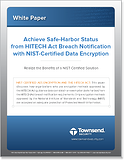Webcast: Four Solutions for Data Privacy Compliance
|
The National Institute of Standards and Technology (NIST) announced the selection of the new Secure Hash Algorithm SHA-3 this week. The winning algorithm is Keccak submitted by the team of Guido Bertoni, Joan Daemen and Gilles Van Assche, and Michaël Peeters. This culminates five years of work by the NIST team and the work of many Cryptologists and security specialists around the world. We owe a huge debt of gratitude to everyone involved in this project. While we are hardly aware of how much we use and depend on the work produced by this community of academics and professionals, it is hard to overestimate how much each of us benefits from this work.
Do I need to do anything right now?
No. The SHA-2 family of hash algorithms is considered secure and there is no near-term concern about this family of secure hash algorithms. Here at Townsend Security, when we reach for a secure hash algorithm, we use SHA-256 from the SHA-2 family, and it is expected to be secure for many years to come.
HOWEVER, if you are using MD5 or SHA-1, it is time to upgrade to SHA-2 , or SHA-3 if you like.
Will this new algorithm change how we do message authentication?
I don’t think so. There is some new flexibility in respect to the length of the generated hash, but the use of SHA-3 is likely to be very similar to SHA-2. The advantage of SHA-3 is that it is not SHA-2. That is, if SHA-2 is found to be weak in some way, it is not likely that SHA-3 will be weak in the same way. Basically, SHA-3 will be used for the same purposes as SHA-2.
Will I need to use a salt with this hash method?
Yes, you would use a salt value with SHA-3 for the same reasons you would for SHA-2 – to avoid dictionary attacks that are often optimized with rainbow tables. Any time you have a small amount of data to hash (think credit card number, social security number, email address, and so forth), it is a good idea to use a salt value, and to take care to protect the salt from disclosure.
Is there any reason NOT to use SHA-3 now?
As Bruce Schneier points out in his book on “Cryptography Engineering”, there are lots of ways to get security software engineering wrong. I don’t worry about the underlying security proofs of the SHA-3 algorithm, but I do worry about bad security software engineering because I’ve seen so much of it. I am sure that NIST will have a validation program for SHA-3 (maybe it is already in place), and security vendors will bring their work through this process. I think there are good reasons to wait for the technology to mature before jumping into using SHA-3.
Pop quiz:
Does the name Joan Daemen ring a bell?
If you remembered his name from the Advanced Encryption Standard (AES) competition some years ago, kudos to you! Joan Daemen and Vincent Rijmen submitted the work that became this important symmetric encryption standard.
Happy Halloween!
Patrick


 Cyber hackers have repeatedly victimized US businesses, resulting in a widespread movement to increase cyber security in many US organizations.
Cyber hackers have repeatedly victimized US businesses, resulting in a widespread movement to increase cyber security in many US organizations.
 Danger looms large in Iran, as the flame virus has been unleashed. Experts say that this is far worse than Stuxnet, and that the world could be on the brink of a new kind of warfare. The emergence of cyber-weaponry over the last few years has alarmed the world with its capabilities and uncertainty. It definitely seems like this is the wave of the future in terms of international conflict and the training in espionage. Just 50 years ago, spies were being trained to tap phones and take incriminating photos. Now that computers virtually run the whole world, the focus, of course, is to invade private hard drives to intercept secure information or to make it inaccessible to the party that controls it.
Danger looms large in Iran, as the flame virus has been unleashed. Experts say that this is far worse than Stuxnet, and that the world could be on the brink of a new kind of warfare. The emergence of cyber-weaponry over the last few years has alarmed the world with its capabilities and uncertainty. It definitely seems like this is the wave of the future in terms of international conflict and the training in espionage. Just 50 years ago, spies were being trained to tap phones and take incriminating photos. Now that computers virtually run the whole world, the focus, of course, is to invade private hard drives to intercept secure information or to make it inaccessible to the party that controls it.

